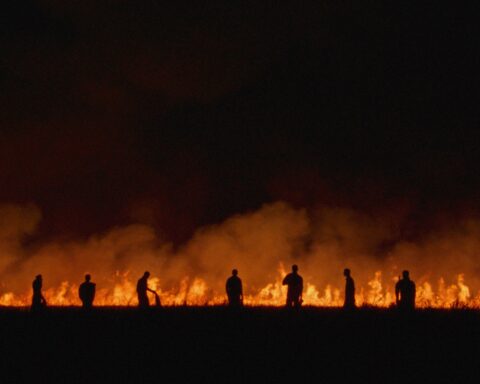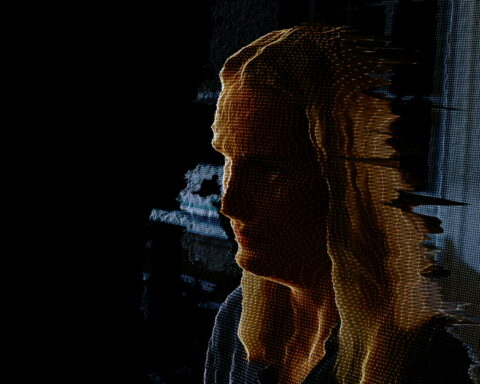Where do you start when it’s time to celebrate an artistic career that already spans over 30 years? Given that the Scotiabank Photography Award is reserved for established Canadian photographers who have made a significant contribution to contemporary art and championed the medium, showcasing their laureates requires grappling with that question. After all, some people will be familiar with the winner’s work, while others will be hearing the name for the first time, unaware of their decades-long dedication to their craft. Custom would have you start at the beginning, working your way through the years towards what would be considered the culmination of one’s practice. Or, you could move backwards, unraveling the artist’s experiences and milestones like you unravel a knit sweater, hoping to get to the source of their creativity. Still, there is a third avenue. You could parse the oeuvre and organise it by themes, identifying the concerns and issues that preoccupy its author.
When it came to presenting the work of this year’s winner, 64-year-old Angela Grauerholz, it made sense to opt for the latter. “She already had a major retrospective at the National Art Gallery, The Inexhaustible Image in 2010, complete with a catalogue,” explains Gaëlle Morel, the curator at the Ryerson Image Center (RIC), a partner of the Scotiabank Photography Award tasked with mounting an exhibition of the honouree. “Poring through her photographs, books and previous installations, I was looking for the element that kept coming back. I wanted to figure out what she was obsessed with. Turns out she is consumed with the idea of archives and collections and the places where these are housed, where they come together. It wasn’t that she produced a specific set of pieces exploring that subject matter, but rather that every series she created throughout her career touched on that topic in one way or another.”
A good way to enter Grauerholz’s world is through her books—or rather their scans—since a personal library is arguably the most revealing collection that any individual can gather. Reviewing the titles in someone’s library can give you a swift, sweeping and deep insight into their psyche. It speaks of what they like, what they studied, what intrigues them and what concerns them. Having shaped the mind of the reader, they are very much part of them. To lose them, for some, would be like losing a limb. This is what happened to Grauerholz; a fire at her home severely damaged her books. Unable to throw them out, she stored them in boxes. A year later, she fished one out and was struck by its incredible beauty as an object. At the same time, she could no longer access the knowledge it held. The flames had made it unreadable. While it retained the form of a book, it no longer functioned like one.
Reflecting on the purpose, format and structure of printed volumes, Grauerholz, who up to that point favoured analog techniques, decided to scan the front and back cover of approximately 400 titles. A few are still identifiable: Word and Object by the philosopher Willard Van Orman Quine, The Gutenberg Galaxy by the media theorist Marshall McLuhan, Signification and Significance by the semiotician Charles Morris, Language and Communication by the psychologist George A. Miller and Camera as a Weapon: Worker Photography between the Wars by curator Leah Ollman. But most have been completely defaced, rendering them nameless and mysterious. “They have become mere image,” muses Grauerholz, preparing a short lecture, “a physical manifestation of their former selves” and “memorials for many ideas, events and memories.” These digital reproductions of her prized possessions tell us about her, about her fascination for how meaning is constructed. Yet, since many are without titles, they also keep much of her concealed. We are left to imagine what other works her shelves held.
The installation Reading Room for the Working Artist (2003-2004) fills some of those gaps. Inspired by an image of the reading room for the U.S.S.R. worker’s club that Alexander Rodchenko designed for the Exposition internationale des arts décoratifs et industriels modernes held in Paris in 1925, Grauerholz designed a similar space. It contained various elements of her personal archive: the photos (including her own), postcards, brochures, newspaper clippings and texts that she has been collecting for as long as she can remember. “I needed to create order in this collection of mine. Reorganise it and give form to something that was at the same time concrete and material and very abstract: ideas, history and ideologies. In other words: my memory. I was hoping to construct, from my archive and the research I was undertaking, a sort of lieu de mémoire [space of memory]. I wanted to develop a project that would demonstrate how we, as artists, not only become aware of, but acknowledge our predecessors, our influences, and thus let our public know about our processes and experiences, which include our readings, the exhibitions we visit and, depending on the artist, day-to-day aspects of our professional and private life,” she explains in a video produced by the Université du Québec: Montréal, where she teaches. “As such, the reading room represents, almost literally, a synthesis of my interests and activities: photography, typography, graphic design, object and furniture design, architecture and, finally, the history of the avant-garde.” She even goes as far as equating it to a “gigantic personal scrapbook.”
What compels an artist to put their inner workings on display in such a way, to be so transparent about their process? As a professor, Grauerholz may be more at ease than most with sharing her knowledge with others. Yet her lifelong reflection on how cultural memory is formed, transmitted and accessed might, in fact, account for why she is so forthright. Already in the late ’80s and early ’90s her work was punctuated with ethereal images of famous memory houses: libraries, museums and other institutions that she does not name.
Unlike her contemporaries Candida Höfer or Ahmet Ertug, she doesn’t set out to celebrate their grandeur. Rather, she encourages us to contemplate them. She focuses on the unremarkable: a curved sofa or a desk covered with files, the chairs pushed back as if their sitters had left in haste; a phantom frame above three wooden seats or scaffolding in front of an altar. There’s a certain pictorialism to them, shrouding them in wistfulness. This style aligns with Grauerholz’s belief that “photography is a recognition of something that exists in the world. It evokes déjà vu. It’s a moment that lingers in your mind.” As such, her practice very much defies the popular “decisive moment,” that instant of utmost significance caught on camera identified by French photojournalist Henri Cartier-Bresson.
“Originally, while at Concordia University, I studied under Tom Gibson, an important Canadian documentary photographer,” recalls the German-born artist, who came to Canada on a student exchange program in 1968. “I felt like I needed to create a filmic moment within photography. I wanted to incorporate the idea of time and movement. A classmate gave me a Brownie Hawkeye camera. It only had two settings: instant or bulb. In darker situations, I used the latter, which meant that it recorded the slight tremors created by my own breathing or the shake in my hand.” Time and movements thus found themselves imprinted on the negative.
With these images, whose subject is prosaic, but whose aesthetic is poetic, Grauerholz reminds us of the humanity of these cultural temples, that their holdings and displays are the doings of men. “In the ’90s, I started playing with the idea of the contextualization of a piece or a body of work. I was being shown at Documenta IX, in a gallery filled with 19th century paintings. I replaced some of the masterpieces with my own photographs. Since then, my practice has evolved into being, amongst other things, a critique of the museum as a space that holds hostage certain works. When they are on display, they are taken out of hostage and made accessible. Otherwise they are tucked away. Now, I’m experiencing it myself; I don’t have access to some of my own work. That’s problematic,” she says.
Gaëlle Morel, who worked with Grauerholz on the exhibition that celebrates her most recent accolade, is very much aware of the dynamics at play within cultural institutions: “As a curator, I recognise that I have the power and the authority to say what goes on the wall and what doesn’t, what we make available and what we don’t. In her work, Angela is talking about us: places where everything is carefully selected, archived, ordered, catalogued. By showing corners, curtains, furniture, empty frames or objects you don’t expect, she disrupts the order and creates disjunctions. Those are the places where history and memory are fashioned and told to you. When you go to the Louvre, you’re being fed what is important, what is art, what is historical. When she presents these places in a different way, she presses you to think of them differently. And since these are the places that shape us as a culture and society, it is vital that we take a closer look a them and interrogate how they work.”
Grauerholz’s installation pieces are where these considerations are most fully conveyed. After her participation in Documenta IX, she blurred the lines between fact and fiction at the Domaine de Kerguéhennec in Brittany, France, producing a series of portfolios she then attributed to a fabricated 19th century woman photographer who obsessively shot the castle’s grounds and inserted them in the museum’s cabinets. She followed with a sculptural display case, Eclogue or Filling the Landscape (1995), which reproduced the conditions enforced for the preservation of fragile works to the point of limiting its viewing to guided tours where staff handled the prints ceremoniously wearing white gloves, frustrating many visitors. Then came Sententia I-LXII, a custom-made museum cabinet housing 31 vertical frames that slide in and out with images on either side. By requiring the public to interact with the work, Grauerholz once again interfered with the custom of galleries, giving the viewer agency over what s/he chooses to see or not see.
Contemplating the dilemmas associated with collecting and archiving is exactly what the two characters in the foreground of La Bibliothèque (1993) seem to be doing. The photograph calls to mind Jorge Luis Borges’ short story written in the midst of the Second World War, “The Library of Babel.” The Argentinian author imagines a place where all the world’s knowledge is kept, where limitless shelves are lined with volumes comprising every possible ordering of 22 letters and three special characters: the period, the comma and the space. It doesn’t matter whether the words formed make sense, because what may seem like mumbo-jumbo one day might be decoded the next. This “indefinite and perhaps infinite” collection of books has inspired artists ever since. In 2015, Jonathan Basile, a writer and programmer, started creating an online version. An algorithm generates pages after pages of what this fictitious library could contain, turning the imagined book repository into a virtual reality. To date, his system has devised roughly 104677 volumes. And, he’s expanded the concept to images, permuting 4096 colours into tableaus of 416 × 640 pixels. Some look like snow on a television screen, others are renowned paintings. Somewhere in there are also, most likely, Grauerholz’s photographs. Everything may be accessible with a few clicks, but in this endless wave of data, how do you find what’s worth spending time on? In the digital age, the question of what to collect remains as relevant as ever.











